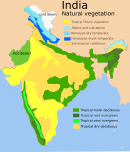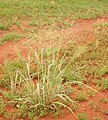
Back بوابة:زراعة Arabic Portál:Zemědělství Czech Portal:Land- und Forstwirtschaft German Portal:Rural Spanish درگاه:کشاورزی Persian Portail:Agriculture et agronomie French Portal:Pertanian ID Portale:Agricoltura Italian Portal:農業と農学 Japanese Vikisritis:Agropedija Lithuanian
The Agriculture Portal

Agriculture encompasses crop and livestock production, aquaculture, and forestry for food and non-food products. Agriculture was a key factor in the rise of sedentary human civilization, whereby farming of domesticated species created food surpluses that enabled people to live in cities. While humans started gathering grains at least 105,000 years ago, nascent farmers only began planting them around 11,500 years ago. Sheep, goats, pigs, and cattle were domesticated around 10,000 years ago. Plants were independently cultivated in at least 11 regions of the world. In the 20th century, industrial agriculture based on large-scale monocultures came to dominate agricultural output.
As of 2021[update], small farms produce about one-third of the world's food, but large farms are prevalent. The largest 1% of farms in the world are greater than 50 hectares (120 acres) and operate more than 70% of the world's farmland. Nearly 40% of agricultural land is found on farms larger than 1,000 hectares (2,500 acres). However, five of every six farms in the world consist of fewer than 2 hectares (4.9 acres), and take up only around 12% of all agricultural land. Farms and farming greatly influence rural economics and greatly shape rural society, effecting both the direct agricultural workforce and broader businesses that support the farms and farming populations.
The major agricultural products can be broadly grouped into foods, fibers, fuels, and raw materials (such as rubber). Food classes include cereals (grains), vegetables, fruits, cooking oils, meat, milk, eggs, and fungi. Global agricultural production amounts to approximately 11 billion tonnes of food, 32 million tonnes of natural fibers and 4 billion m3 of wood. However, around 14% of the world's food is lost from production before reaching the retail level.
Modern agronomy, plant breeding, agrochemicals such as pesticides and fertilizers, and technological developments have sharply increased crop yields, but also contributed to ecological and environmental damage. Selective breeding and modern practices in animal husbandry have similarly increased the output of meat, but have raised concerns about animal welfare and environmental damage. Environmental issues include contributions to climate change, depletion of aquifers, deforestation, antibiotic resistance, and other agricultural pollution. Agriculture is both a cause of and sensitive to environmental degradation, such as biodiversity loss, desertification, soil degradation, and climate change, all of which can cause decreases in crop yield. Genetically modified organisms are widely used, although some countries ban them. (Full article...)
Selected article

India is the largest producer in the world of fresh fruit, anise, fennel, badian, coriander, tropical fresh fruit, jute, pigeon peas, pulses, spices, millets, castor oil seed, sesame seeds, safflower seeds, lemons, limes, cow's milk, dry chillies and peppers, chick peas, cashew nuts, okra, ginger, turmeric guavas, mangoes, goat milk and buffalo milk and meat. India is also the largest producer of millets like Jowar Bajra and Ragi. It is second only to China in the production of rice. India is the 6th largest coffee producer in the world It also has the world's largest cattle population (281 million). It is the second largest producer of cashews, cabbages, cotton seed and lint, fresh vegetables, garlic, egg plant, goat meat, silk, nutmeg. mace, cardamom, onions, wheat, rice, sugarcane, lentil, dry beans, groundnut, tea, green peas, cauliflowers, potatoes, pumpkins, squashes, gourds and inland fish. It is the third largest producer of tobacco, sorghum, rapeseed, coconuts, hen's eggs and tomatoes. India accounts for 10% of the world fruit production with first rank in the production of mangoes, papaya, banana and sapota.
India's population is growing faster than its ability to produce rice and wheat.
Per the World Bank's "India Country Overview" in 2008:
(Full article...)"Slow agricultural growth is a concern for policymakers as some two-thirds of India’s people depend on rural employment for a living. Current agricultural practices are neither economically nor environmentally sustainable and India's yields for many agricultural commodities are low. Poorly maintained irrigation systems and almost universal lack of good extension services are among the factors responsible. Farmers' access to markets is hampered by poor roads, rudimentary market infrastructure, and excessive regulation."
— World Bank: "India Country Overview 2008"
Selected image
Did you know...
General images
Related portals
Topics
Categories
Things you can do
- – When a task is completed, please remove it from the list.
WikiProjects

Associated Wikimedia
The following Wikimedia Foundation sister projects provide more on this subject:
-
Commons
Free media repository -
Wikibooks
Free textbooks and manuals -
Wikidata
Free knowledge base -
Wikinews
Free-content news -
Wikiquote
Collection of quotations -
Wikisource
Free-content library -
Wikiversity
Free learning tools -
Wiktionary
Dictionary and thesaurus
Agriculture journals

- Agronomy Journal - the American Society of Agronomy
- Agronomy for Sustainable Development Journal
- European Journal of Agronomy
- Journal of Agronomy and Crop Science
- Journal of Organic Systems
- Agriculture, Ecosystems & Environment
- Agriculture and Human Values
- Computers and Electronics in Agriculture
- Precision Agriculture
- Experimental Agriculture
- Journal of Integrative Agriculture
- Journal of the Science of Food and Agriculture
- Renewable Agriculture and Food Systems
- Biological Agriculture & Horticulture
See also:


































































